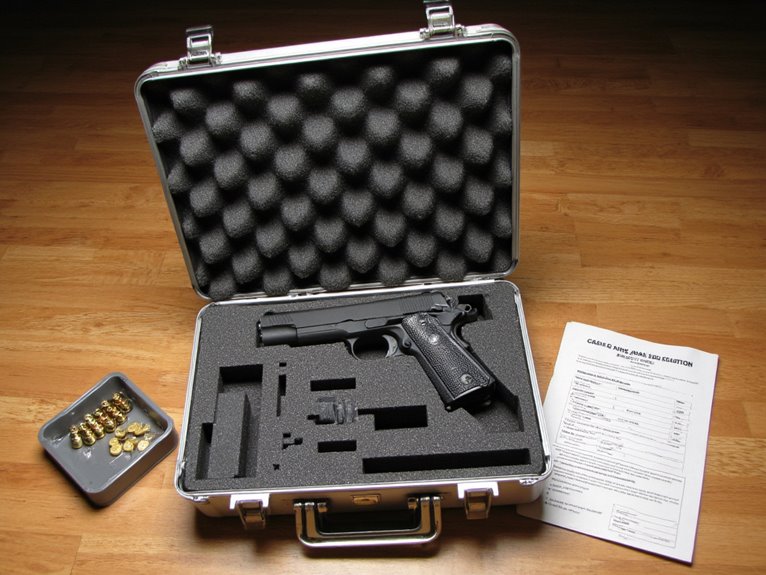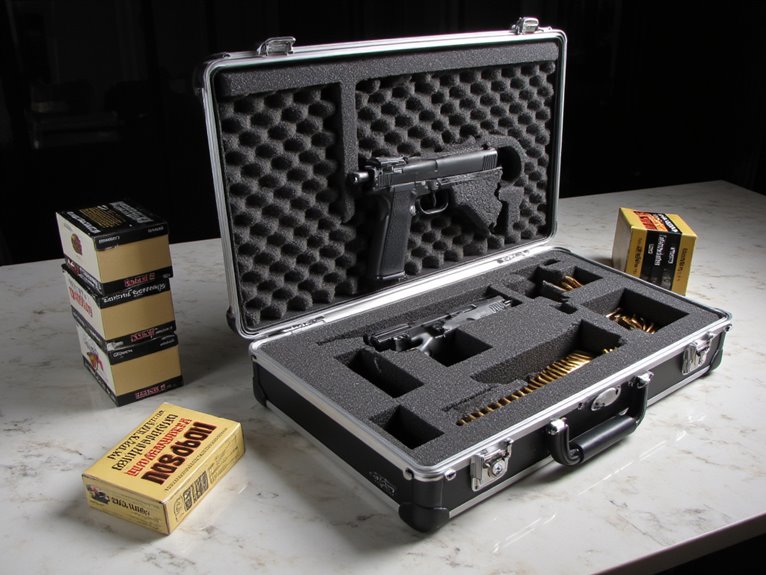How to Pack Your Firearm Safely for Air Travel
You must transport firearms unloaded in hard-sided, locked containers through checked baggage only, declaring them at the airline counter before check-in. Remove all ammunition from the firearm and visually inspect chambers, using chamber flags for confirmation. Pack ammunition separately in approved fiber, wood, plastic, or metal containers, with weight limits typically capped at 11 pounds. Complete declaration forms and allow extra time for TSA inspection processes. Following these protocols guarantees compliance while avoiding penalties up to $17,062 and additional consequences outlined below.
We are supported by our audience. When you purchase through links on our site, we may earn an affiliate commission, at no extra cost for you. Learn more. Last update on 27th December 2025 / Images from Amazon Product Advertising API.
Notable Insights
- Firearms must be completely unloaded, visually inspected, and transported in hard-sided, locked containers via checked baggage only.
- Declare your firearm at the airline ticket counter using clear language and complete the required declaration form.
- Pack ammunition in approved containers made of fiber, wood, plastic, or metal, staying within airline weight limits.
- Use TSA-approved hard cases with reliable locks and foam inserts to prevent firearm movement during transit.
- Research and comply with federal regulations and state laws for all jurisdictions along your travel route.
Legal Requirements and Regulatory Compliance
When you’re planning to travel with firearms, understanding federal regulations isn’t optional—it’s mandatory for legal compliance and avoiding severe penalties.
TSA legal definitions are precise: firearms include complete weapons, frames, and receivers. However, certain firearm types have exceptions—rifle scopes qualify for carry-on transport.
You must transport all firearms unloaded in hard-sided, locked containers exclusively through checked baggage. Declaration at the airline counter is mandatory before checking bags. TSA considers firearms “loaded” if you have simultaneous access to both weapon and ammunition during screening, regardless of separate storage locations. Original cases from firearm purchases may not provide adequate security for transport requirements.
Airlines permit up to 11 lbs of ammunition in checked luggage with proper packaging requirements.
Violations carry severe consequences. Fines reach $17,062, TSA PreCheck removal for five years minimum, and potential federal prosecution.
You’re responsible for compliance with departure and destination laws, which vary considerably between jurisdictions. For vehicle transport to the airport, consider using portable gun safes to maintain secure firearm storage during travel.
Proper Firearm Preparation and Unloading Procedures

Proper preparation begins with absolute verification that your firearm contains zero ammunition before any packing occurs. You must completely unload your weapon and visually inspect all chambers.
For semi-automatic pistols, remove the slide from the frame and place it alongside—this firearm disassembly tip clearly demonstrates the weapon’s non-functional state to TSA agents. With revolvers, open the cylinder and confirm it’s empty. Never use snap caps, as agents might mistake them for live rounds.
Chamber flags provide excellent visual confirmation of proper unloading techniques. These bright-colored indicators signal compliance and enhance safety verification.
TSA agents will perform chemical swabs and thorough inspections to confirm your weapon contains no ammunition. Allow extra time for this mandatory verification process, as any oversight will delay your departure. During inspection, you may need to unlock your case so agents can conduct a physical inspection of the firearm. Keep a printed copy of TSA regulations in your gun case for reference during any questions or clarifications that may arise.
Selecting and Securing the Right Hard-Sided Case
Your firearm’s protection during air travel depends entirely on selecting a hard-sided case that meets both TSA regulations and withstands the rigorous handling of commercial aviation.
Proper case selection requires durable materials like high-strength polypropylene or aluminum with waterproof, dustproof gasket-sealed designs. Military-grade options such as Pelican Air Cases provide crushproof protection for harsh conditions.
Security features must include reliable locking mechanisms meeting TSA standards. You’ll need personal keyed or combination locks—never TSA luggage locks, as agents possess universal keys. Only you should have access to your case’s key or combination.
Interior protection involves customizable foam inserts that create precise cutouts for your firearm and accessories. This prevents movement and scratching during transport.
Choose cases with lifetime warranties for long-term reliability and manufacturer support. The same airtight seals used in waterproof gun safes help ensure your case maintains protection against moisture intrusion during flight.
Ammunition Packing and Separation Guidelines
You must pack your ammunition in approved containers made of fiber, wood, plastic, or metal that are specifically designed for small quantities of ammo.
Loose ammunition or rounds stored in unapproved containers won’t pass TSA inspection and are prohibited in both checked and carry-on baggage.
Airlines typically impose strict quantity limits on ammunition weight per passenger, so you’ll need to verify your carrier’s specific restrictions before packing to avoid rejection at check-in.
Proper Ammunition Containers
When transporting ammunition by air, you’ll need specific containers that meet both TSA and airline safety standards. Approved container types include fiber (cardboard), wood, or metal boxes designed for small ammunition quantities.
Hard-sided waterproof cases from brands like Pelican or SKB offer superior protection and meet regulatory requirements.
Your ammunition magazines must be completely enclosed in holders, pouches, or holsters to prevent loose rounds from shifting during transit. You can pack ammunition inside the same locked hard-sided case as your firearm, provided it’s properly secured within dedicated compartments.
Essential packing tips include avoiding loose placement with clothing or toiletries. Instead, confine magazines and ammunition to designated compartments or separate containers.
This prevents movement and potential damage while ensuring compliance with airline policies and TSA security standards.
Quantity and Limits
Beyond selecting appropriate containers, understanding ammunition quantity restrictions and separation requirements prevents costly delays and potential confiscation at security checkpoints.
You’re limited to 5 kg (11 pounds) of ammunition per traveler internationally. This weight limit applies regardless of ammunition types or weight variations between cartridges—a .22 LR weighs considerably less than .308 Winchester rounds, but your total can’t exceed 11 pounds.
Individual airlines may impose stricter limits than TSA regulations. Confirm policies before departure. Exceeding limits triggers additional screening and potential refusal of transport.
Your ammunition must remain separated from firearms unless stored within the same locked hard case. Whether packed together or separately, all ammunition requires proper containment in fiber, wood, or metal boxes designed for safe cartridge transport during transit.
Airport Declaration and Check-In Process
When you arrive at the airport with your firearm, you must declare it at the airline ticket counter using clear, calm language such as “I am traveling with a firearm.”
The airline agent will require you to open your firearm case for inspection to verify the weapon is unloaded and properly stored in compliance with regulations.
You’ll then complete the required declaration form or card, which gets placed on or near your firearm case depending on whether you’re checking a pistol inside luggage or a long gun in its own dedicated case.
Consider using a TSA-friendly case that opens fully flat to expedite the inspection process and reduce delays at security checkpoints.
Ticket Counter Declaration
The ticket counter declaration represents the most critical step in legally transporting your firearm by air. You must declare your firearm directly to the airline agent—never at TSA security checkpoints. This ticket declaration initiates mandatory paperwork and verification procedures.
Present your firearm in a locked, hard-sided container for inspection. Airline staff will conduct chamber checks and witness case locking procedures. Use discreet language like “special declaration for checking a firearm” to avoid alarming other passengers.
| Declaration Step | Required Action |
|---|---|
| Verbal Declaration | Use discreet language with agent |
| Container Presentation | Locked, hard-sided case required |
| Paperwork Completion | Sign unloaded firearm verification |
| Tag Placement | Inside container with firearm |
| Post-Check Wait | Remain 10-15 minutes in public area |
Different airline procedures may require additional forms or escort to secure areas for verification.
Required Documentation Process
Once you’ve properly secured your firearm in an approved container, completing the required documentation becomes your next critical responsibility. You must complete and sign a declaration form at the airline’s check-in counter—never at the TSA checkpoint. This form accompanies your firearm throughout transport and must be placed on or inside your case.
All firearms require declaration, including frames, receivers, and 3D-printed components per current firearm regulations. The check-in agent will inspect your luggage to verify unloaded status and proper storage. You’ll sign the declaration card during this inspection.
Carry printed TSA regulations as reference material. Use professional language like “traveling with a firearm” rather than casual terms.
Wait 10-15 minutes after check-in before proceeding to security, allowing time to address any packing issues.
Route Planning and State Law Considerations
Although air travel with firearms involves federal regulations, you’ll face a complex web of state laws that varies dramatically across your route. State specific laws govern possession, transport, and carry permits differently.
New York, New Jersey, and Illinois maintain particularly restrictive regulations that could criminalize lawful possession from your departure state.
Research firearm transport regulations for every state you’ll fly over or transit through. Your concealed carry permit may lack reciprocity in certain jurisdictions.
State firearm laws vary drastically along travel routes, and your carry permit may not be recognized everywhere.
Plan routes using single airlines or partner carriers to avoid rechecking firearms in restrictive states. Choose nonstop flights when possible to minimize exposure to varying state laws.
Understanding 18 U.S.C. § 926A provides federal protection for interstate transport, but only when firearms remain unloaded and locked during transit through restrictive states.
TSA Security Screening and Penalty Awareness
When you arrive at the airport with a firearm, TSA’s security screening process follows strict protocols that you must understand to avoid serious penalties.
Your checked firearm case undergoes routine X-ray screening, but TSA officers won’t open locked containers. Only you can access your firearm locks during the screening process.
Penalty implications for violations are severe and escalate with repeat offenses. First-time violations result in civil penalties and immediate revocation of TSA PreCheck privileges. Enhanced security screening applies to future travel.
Repeated violations extend disqualification periods and increase financial penalties.
TSA’s screening protocols prohibit firearms in carry-on baggage entirely. Accidental carry-on violations trigger immediate law enforcement involvement. Discovery at checkpoints creates significant delays and safety risks for all passengers, emphasizing the critical importance of proper declaration and checked baggage placement.
On a final note
You’ve now covered the essential protocols for legally transporting firearms by air. Following these regulations isn’t optional—it’s mandatory. Double-check your hard-sided case meets TSA specifications. Verify ammunition separation requirements. Complete declaration forms accurately at check-in. Research state laws for your destination and layover locations. Non-compliance results in federal penalties, confiscation, and potential criminal charges. Your attention to these details guarantees safe, legal transport while protecting your rights as a lawful gun owner.

